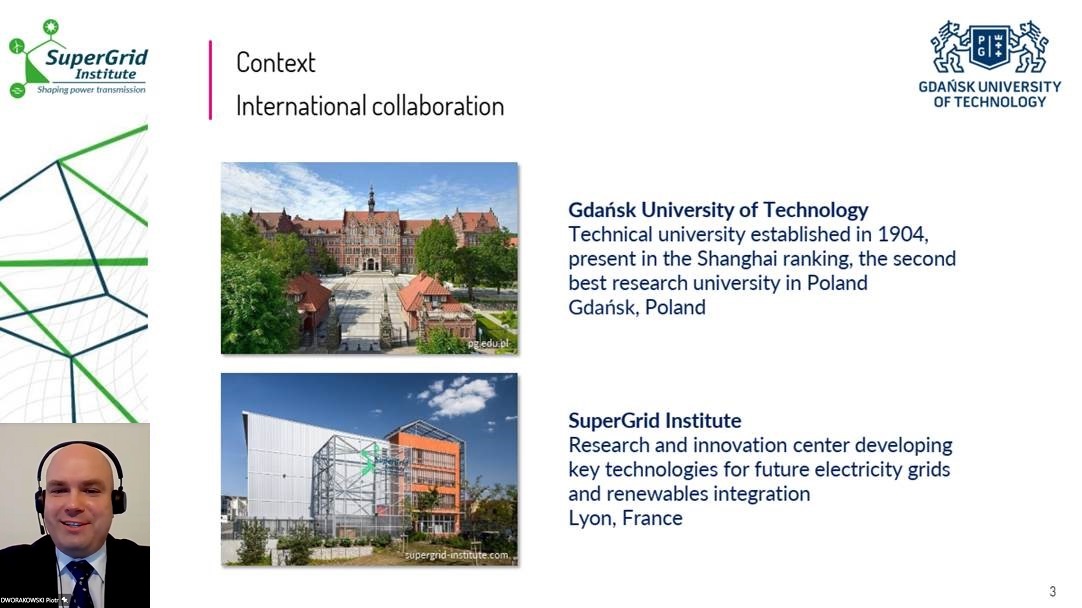PhD Piotr DWORAKOWSKI “Modelling and analysis of medium frequency transformers for power converters”

Abstract
The evolutions in power systems and electric vehicles, related to the economic opportunities and the environmental issues, bring the need of high power galvanically isolated DC-DC converter. The medium frequency transformer (MFT) is one of its key components, enabled by the increasing switching frequency of modern power semiconductors like silicon carbide transistors or diodes. The increased operating frequency offers small converter size, leading to the decrease in raw material usage. Most likely this will result in the converter cost reduction what will further increase the demand for solid state transformer solutions. The modelling and analysis are essential in the development of the MFT technology which is attracting lots of research and industrial interest.
In this dissertation the isolated DC-DC converter topologies are introduced with the particular focus on the dual active bridge (DAB). The key components of the isolated DC-DC converters, power semiconductors and medium frequency transformer are reviewed.
A mathematical model of a 3-phase MFT in the isolated DC-DC power converter, suitable in electromagnetic transient and steady state simulation is developed. The transformer modelling methods are reviewed and the Lagrange energy method is used to derive a physically motivated model for circuit analysis. The model involves a matrix of nonlinear magnetizing inductances and a matrix of linear leakage inductances, both including self and mutual values. The macroscopic models of magnetic hysteresis are reviewed and the feedback Preisach model is developed.
The design of a 3-phase 20 kHz transformer for a 100 kW 1.2 kV isolated DC-DC power converter is presented. The particular focus is put on the winding and core design, and power loss and thermal calculations which are the most critical aspects of the high-power density transformer. The design results in two 3-phase MFT prototypes, first of its kind worldwide.
A finite element model of the transformer is developed allowing to determine the magnetic flux characteristic Φ(Θ) and the related inductances required in the circuit model. The finite element model is based on the measured equivalent B(H) and homogenized material properties. Other model parameters are calculated analytically and compared against the measurement on the prototype MFT.
The dissertation is concluded showing the technical feasibility and benefits of the 3-phase MFT. The developed MFT prototype operating at 20 kHz is more than 10 times lighter than the equivalent 50 Hz transformer. The 3-phase 100 kW DC-DC converter efficiency is measured 99.2% what is an impressive result. The efficiency of the 3-phase DC-DC is higher than its equivalent single-phase variant.
A challenge of high power MFT design related to the parasitic air gaps in the core is highlighted. The influence of the air gaps on core power loss is confirmed showing that the increase in the air gap size in a certain range causes a decrease in the core power loss. In the 3 phase MFT prototype the parasitic air gaps do not cause any measurable effect on winding power loss and temperature. It is shown that the relative magnetic permeability is nonlinearly decreasing with the increase of the number of parasitic air gaps. An exponential interpolation function is proposed allowing to estimate the equivalent magnetic permeability, average air gap length and magnetizing inductance for any high-power ferrite core MFT with a similar core assembly.
The proposed MFT equivalent circuit model is proven accurate in steady state and transient analyses. The no-load inrush test confirms the importance of the magnetic cross saturation involved in the magnetizing inductance model. The influence of the mutual leakage inductance on the operation of the DAB converter is shown. The feedback Preisach model of hysteresis is proven accurate in the modelling of hysteresis loops in the multi air gap ferrite core MFT.
Thesis director and co-director
Prof. Andrzej Wilk, Dr Michał Michna, Gdańsk University of Technology


